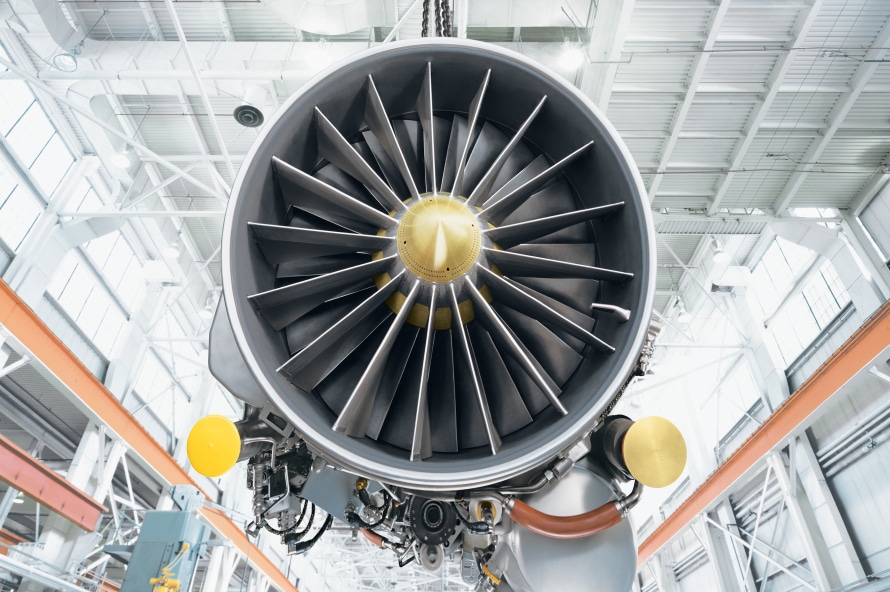Aerospace
GE eyes multi-billion dollar engine deal with India for fighter jet programs

While the design of the aircraft manufacturing is rapidly progressing under the AMCA and TEDBF project. Now, the engine manufacturer is promising to provide HAL with the technology. In order to participate in the Indian future fighter lead design manufacture, GE is now prepared to express its interest.
General Electric (GE), a major American aerospace engine manufacturer, has submitted an application to the Pentagon asking for permission to jointly produce and share engine technology with India. The Pentagon has brought up the matter with the appropriate authorities, and the proposal is moving quickly as a result of the urgency displayed by GE, which is eager to expand its business in India with a multi-billion dollar engine deal for Indian fighter jet programs.
A military turbofan engine built by General Electric Aviation is known as the GE F114. Current applications include the F-15E Strike Eagle, F-16 Fighting Falcon, and other military aircraft. It was initially created for the F-14 Tomcat fighter aircraft.
The modular design of the F114 engine makes maintenance and repair simple. It is able to travel at supersonic speeds and has a maximum thrust of about 29,000 pounds. Additionally, the engine is equipped with cutting-edge technologies like an afterburner for improved performance and a digital engine control system.
Overall, the GE F114 engine is a strong and dependable engine that has been instrumental in the development of numerous military aircraft.
For the Indian Navy’s Advanced Medium Combat Aircraft (AMCA) and Twin Engine Deck Based Fighter (TEDBF) fifth-generation fighter programs, GE has requested authorization to jointly build a 110kn engine based on its F414 engine.
For the 4.5+ Gen Tejas MkII fighter program in India, GE intends to jointly produce a baseline F414 engine that generates a 98kN class of thrust. Moreover, GE wants to create an upgrade core that can provide 110-120kN Class of thrust for the AMCA and TEDBF Program.
For each fighter program over its life cycle, GE estimates a massive deal for 400 engines from India alone, with up to 1000 engines being produced locally in India. Due to the Tejas Mk1A program, GE has an advantage over its rivals in India. GE is eager to fend off offers from Safran and Rolls-Royce by providing engines that are not only economical but also include Transfer of Technology (ToT) for domestic production.

Aerospace
Boeing Transfers Rocket Stage to NASA, Paving Way for Human Moon Mission

Boeing has achieved a significant milestone by providing NASA with the second core stage of the Space Launch System (SLS) rocket.
This crucial component, crafted at NASA’s Michoud Assembly Facility (MAF), is set to propel the Artemis II crew into lunar orbit, marking humanity’s return to deep space after a 50-year hiatus.
The monumental Boeing-built rocket stage, the largest element of the Artemis II mission, will embark on a journey aboard the Pegasus barge, traveling 900 miles to NASA’s Kennedy Space Center.
Comparison of two legendary aircraft B777x vs B747 aircraft:Click here
Upon arrival, it will be meticulously integrated with other essential Artemis II components, including the upper stage, solid rocket boosters, and NASA’s Orion spacecraft within the iconic Vehicle Assembly Building. This intricate integration process is a vital step toward the eagerly anticipated Artemis II launch, slated for 2025.
“Boeing-built products helped land humankind on the moon in 1969, and we’re proud to continue that legacy through the Artemis generation,” remarked Dave Dutcher, vice president and program manager for Boeing’s SLS program. “Together, with NASA and our industry partners and suppliers, we are building the world’s most capable rocket and paving the way to deep space through America’s rocket factory in New Orleans.”
NASA, Lockheed Martin Reveal X-59 Quiet Supersonic Aircraft:Click here
The delivery of Core Stage 2 marks a significant achievement in the evolution of the SLS rocket. Towering over 200 feet and powered by four RS-25 engines, this core stage, coupled with two solid-fueled booster rockets, will generate a staggering 8.8 million pounds of thrust. This immense power is crucial to launching Artemis II and future missions into the vast expanse of space.
The SLS rocket stands unparalleled in its capability to transport both crew and substantial cargo to the moon and beyond in a single launch. Its extraordinary capacity will facilitate the delivery of human-rated spacecraft, habitats, and scientific missions to destinations including the moon and Mars, ushering in a new era of space exploration.
-

 Travel1 week ago
Travel1 week agoAir India to Expand US Operations with Three New Routes After a Decade
-

 Travel2 weeks ago
Travel2 weeks agoWhy We Should Avoid These Stamps in a Passport
-

 Airlines1 month ago
Airlines1 month agoInvestigations Reveal Fake Chinese Titanium in Boeing and Airbus Jets
-

 Tech4 weeks ago
Tech4 weeks agoChina’s CATL Plans 1,800-Mile Electric Plane Launch by 2027
-

 Airport3 days ago
Airport3 days agoTop 10 Largest Airports in the World by Size
-

 Aerospace4 weeks ago
Aerospace4 weeks agoChina’s Fighter Jets Turn Wings into Autonomous Drones
-

 Airlines4 days ago
Airlines4 days agoAir India Rolls Out A350s for Delhi-New York JFK and Newark Routes
-

 Defence3 weeks ago
Defence3 weeks agoBoeing Enhances Chinook with New Engines and Block II Upgrades at $96 Million







